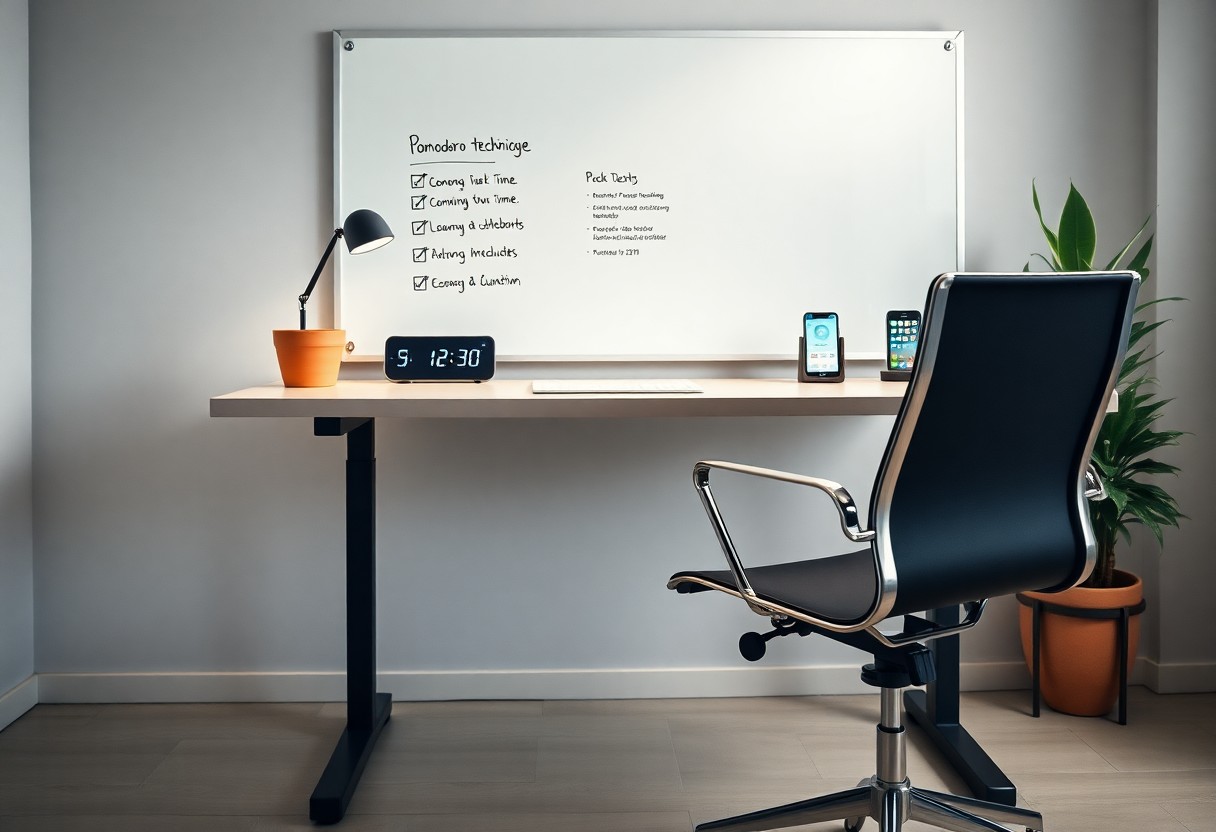Over the next few minutes, you will discover how to harness the Pomodoro technique to enhance your productivity and maintain consistent focus. This time management method, designed to improve concentration, involves breaking your work into 25-minute intervals followed by short breaks. By implementing this technique into your routine, you can combat distractions, prioritize tasks effectively, and ultimately achieve your goals with greater efficiency.
Key Takeaways:
- Work in 25-minute intervals, known as Pomodoros, followed by a 5-minute break.
- After completing four Pomodoros, take a longer break of 15-30 minutes.
- Use a timer to track your work intervals and breaks effectively.
- Limit distractions during Pomodoros to maximize productivity.
- Prioritize tasks by creating a to-do list before starting your Pomodoros.
- Adjust the duration of working intervals and breaks based on personal needs.
- Review your progress at the end of each day to enhance future planning.

Decoding the Pomodoro Technique: Time Management with a Twist
The Pomodoro Technique transforms conventional time management by restructuring your work into manageable intervals. By breaking tasks into 25-minute focused sessions, you can enhance productivity and minimize mental fatigue. This method emphasizes the value of short breaks, promoting sustained energy and creativity throughout your day. Incorporating this approach encourages a balance between work and rest, ultimately allowing you to maintain sharper focus on your tasks.
The Four-Step Process Explained
Executing the Pomodoro Technique involves a straightforward four-step process. Begin by choosing a task, setting a timer for 25 minutes, and concentrating solely on that task for the duration. Once the timer rings, take a 5-minute break to recharge. After completing four Pomodoros, enjoy a longer break of 15 to 30 minutes. This cyclical process facilitates a rhythm that enhances concentration and discourages distractions.
Origins and Evolution of Pomodoro
The Pomodoro Technique was developed in the late 1980s by Francesco Cirillo. He used a tomato-shaped kitchen timer to track his work sessions, leading to the name “Pomodoro,” which means tomato in Italian. Over the years, this simple yet effective technique has evolved, becoming widely adopted by students and professionals alike to combat procrastination and improve focus.
Cirillo’s innovation stemmed from his struggles with time management and productivity during university. By experimenting with short bursts of work, he discovered that the pressure of a ticking timer not only heightened his concentration but also reduced mental strain. As the technique gained traction, it became a foundation for numerous productivity tools and apps, demonstrating its adaptability to various work environments. Today, the Pomodoro Technique remains a popular choice for those seeking to optimize their time management skills and achieve greater focus in both personal and professional contexts.

Creating Your Ideal Work Environment for Maximum Focus
Your workspace significantly impacts your ability to focus while using the Pomodoro technique. Ensure that your environment is conducive to productivity by keeping it clean, organized, and comfortable. Consider using natural light or appropriate artificial lighting and maintaining a comfortable temperature. A dedicated workspace, free from clutter and interruptions, helps you stay in the right mindset for concentration and effectiveness.
Minimizing Distractions: The Art of Preparation
Preparation plays a vital role in minimizing distractions during your Pomodoro sessions. Before starting, clear your workspace of unnecessary items and inform those around you of your focused time. Turn off notifications on your devices and use noise-canceling headphones if necessary. This proactive approach reduces interruptions, allowing you to immerse yourself in your tasks and maximize productivity.
Tools and Apps to Enhance Your Pomodoro Sessions
Integrating specific tools and apps into your Pomodoro routine can greatly improve focus and productivity. Various Pomodoro timers, such as Forest and Focus Booster, provide structured intervals and track your session length. Additionally, productivity apps like Todoist and Trello can help prioritize tasks, ensuring you stay focused on what is most important during each Pomodoro. These resources allow you to manage your time effectively and adhere to your planned sessions.
Popular tools like Focus@Will offer curated music designed to enhance concentration during writing or studying. For those who prefer visual reminders, apps like Be Focused allow you to quickly adjust your work intervals and take breaks. The integration of analytics into these tools can offer valuable insights into your productivity trends, showing improvements over time or pinpointing areas for adjustment. Choosing the right tools aligns your intentions with a structured approach, further solidifying your focus during Pomodoro sessions.

Mastering Your Focus with Structured Breaks
Structured breaks enhance your focus while practicing the Pomodoro technique. These breaks rejuvenate your mind, allowing you to return to your tasks with renewed energy and sharper concentration. By incorporating short, purposeful pauses between work sessions, you can maintain productivity and prevent burnout. Emphasizing the importance of timing, each break serves as a reset, helping you to sustain high levels of engagement throughout your work periods.
The Psychological Benefits of Frequent Breaks
Frequent breaks positively impact your mental well-being. They reduce stress and anxiety levels, promoting a more relaxed and focused mindset. Research shows that taking short breaks enhances your cognitive performance, as it allows your brain to consolidate information. As you step away, even briefly, your mind processes what you’ve learned, improving retention and understanding. This shift not only boosts your creativity but also makes returning to complex tasks feel less daunting.
Long Breaks vs. Short Breaks: Finding Your Balance
Balancing short and long breaks is key to maximizing productivity. Short breaks, typically lasting 5 minutes, can refresh your focus, while longer breaks, around 15 to 30 minutes, allow for deeper mental recovery. Tailoring the duration and frequency of your breaks based on your individual work style enhances effectiveness. Test different intervals to identify what refreshes your mind best, acknowledging that some tasks may require a shorter focus span while others benefit from extended deep work sessions.
In practice, integrating both short and long breaks into your Pomodoro sessions can optimize your workflow. For example, after completing four Pomodoros, dedicating a 30-minute break allows your mind to disengage fully, supporting sustained focus when you return. This method caters to varying levels of task complexity. You may find that shorter tasks thrive on frequent, brief pauses, while longer, more demanding projects benefit from less frequent but extended intervals. Experiment with different schedules and take note of how your productivity and focus fluctuate, enabling you to establish a balanced routine that works best for you.
Customizing the Pomodoro Technique for Unique Needs
Adjusting the Pomodoro technique can enhance its effectiveness to suit your specific work habits and preferences. Modifying the lengths of work and break periods ensures that you maintain productivity without feeling overwhelmed. Tailoring this method to various environments can also maximize focus and efficiency, allowing you to find the best rhythm for your tasks. Personalization enables you to strike a balance between work intensity and restorative breaks, enhancing your overall productivity.
Adapting Lengths of Work and Break Periods
Every individual has a different attention span and energy level throughout the day. You may find that extending work sessions to 40 minutes, followed by a 10-minute break, keeps you engaged longer, or perhaps a shorter 15-minute interval works better for you. Experimenting with various lengths allows you to discover your optimal routine, ultimately leading to increased focus and reduced fatigue during work periods.
Tailoring the Method to Various Work Environments
Your work environment can significantly alter how effective the Pomodoro technique is for you. In a noisy setting, using noise-canceling headphones and shorter work intervals may help maintain concentration, while a quieter space allows for longer, uninterrupted sessions. Adjust the timing and methods based on environmental factors—if distractions are frequent, increase the duration of breaks to reset your focus after each burst of work. By aligning the technique with your surroundings, you can sustain a higher level of productivity.
Common Pitfalls and How to Overcome Them
Even with the best intentions, pitfalls can disrupt your Pomodoro practice. One common challenge is the tendency to lose focus during breaks, whether by mindlessly scrolling through social media or checking emails. Stay mindful of your break activities to maintain productivity. Setting a timer for breaks can keep you accountable and prevent extended distractions. Additionally, reevaluate your goals often to ensure they align with your overall objectives, adjusting as necessary to maintain motivation and clarity.
Staying on Track with Your Goals
Your goals should be clear and specific to maximize the effectiveness of the Pomodoro technique. Break larger tasks into smaller, manageable chunks that can be completed in one or two Pomodoros. Regularly review your progress towards these goals, adjusting your focus areas as needed. This approach keeps your productivity aligned with your objectives and helps you assess your performance accurately, ensuring you remain engaged and motivated.
Dealing with Interruptions and Rescheduling
Interruptions are inevitable, but how you manage them can determine your success with the Pomodoro technique. It’s vital to develop a strategy that allows you to address unexpected distractions without derailing your focus. Consider designating specific times for meetings or collaborative tasks outside your Pomodoro sessions, thus preserving your focus periods. If you’re disrupted during a Pomodoro, jot down the interruption and return to your task promptly once you’re able.
When interruptions occur, maintaining a clear record of what derailed your focus helps you identify patterns over time. For instance, if you’re frequently interrupted by urgent emails, consider setting specific times throughout the day for checking messages. Communicate your focused work periods to colleagues or family, establishing boundaries that allow you to prioritize your Pomodoros. Rescheduling a disrupted Pomodoro for later in the day, while keeping track of what tasks remain, enables you to restore your workflow seamlessly and efficiently.
Conclusion
Ultimately, using the Pomodoro technique effectively requires you to break your work into manageable intervals, setting clear goals for each session. By dedicating 25 minutes to focus followed by a 5-minute break, you enhance your productivity and maintain your concentration. Track your progress and adjust intervals as needed to fit your personal workflow. This structured approach not only helps reduce distractions but also promotes a balanced mindset, leading to improved efficiency and better results in your tasks.
FAQ
Q: What is the Pomodoro Technique?
A: The Pomodoro Technique is a time management method that involves breaking work into intervals, traditionally 25 minutes in length, separated by short breaks. This helps maintain focus and productivity.
Q: How do I start using the Pomodoro Technique?
A: Begin by choosing a task. Set a timer for 25 minutes, work on the task until the timer rings, then take a 5-minute break. Repeat this cycle four times, then take a longer break of 15-30 minutes.
Q: Can I adjust the length of the work intervals?
A: Yes, you can customize the work intervals to fit your preferences. Some people work better with longer or shorter sessions; just ensure the intervals maintain a balance between focus and rest.
Q: What should I do during the breaks?
A: Use breaks for activities that help you recharge, such as stretching, walking, meditating, or having a snack. Avoid screens or work-related tasks during this time.
Q: How can I track my Pomodoro sessions?
A: You can use a simple timer or Pomodoro-specific apps that track your sessions, breaks, and overall productivity. Keeping a log may help assess your work patterns over time.
Q: Is the Pomodoro Technique effective for all types of work?
A: The Pomodoro Technique works well for many tasks, especially those requiring sustained focus. However, it may not suit every type of task, especially those that require longer, uninterrupted periods of concentration.
Q: How do I handle interruptions during a Pomodoro session?
A: If interrupted, try to minimize distractions and return to your task as quickly as possible. If the interruption is significant, you may choose to reset the timer and start the Pomodoro session again.
